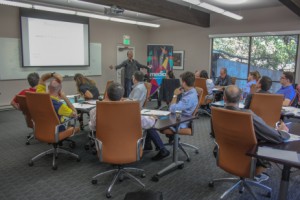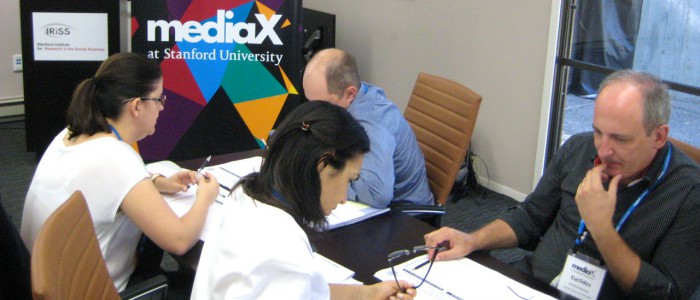Products based on real needs are more efficient — IntoActions collaborates with Stanford/MediaX
Palo Alto, October 8, 2014 – “Industries are developing products and services to resolve problems that often don’t even exist. Using a methodology based on real-life needs and the problems faced by users can help us develop more efficient solutions,” said Reinhold Steinbeck, researcher in the field of Design Thinking, during a workshop geared toward technology for safety and security. A delegation from Santa Catarina, Brazil, was at Stanford University to take part in a workshop that simulated the creative process to solve complex problems.
For Steinbeck, Design Thinking, a human-centered methodology for innovation, can help to create a range of innovative solutions. “Change in human behavior — the principal challenge faced by the SESI Institute for Innovation — will be achieved when people are understood in their essence, when there’s a true comprehension of their physical and emotional needs,” he explained, adding that industries can also use this methodology to improve the experience of their clients; perfect internal processes; and allow for greater interaction with their target audience or customers, along with organizations.

Reinhold Steinbeck, researcher of Design Thinking, conducts a workshop on design thinking in security and health at Stanford University (Photo: Miriane Campos)
The SESI Institute for Innovation in Technology for Workplace Security and Health will offer industries a Design Thinking Lab, which will foster the process of creation, collaboration, communication, and stimulation of creativity, along with being a research space where innovative tools and techniques can be tested. “Industries will be able to debate, analyse and evaluate their corporate problems and challenges, creating study and co-creation groups to explore possible solutions,” explains Steinbeck.
The delegation from Santa Catarina also visited a Virtual Laparoscopy Lab, which offers learning tools that allow for the detailed study of human anatomy and physiology. The lab, which is part of the program SIMDesign, is used for several different areas of medicine, including training students and researchers in surgery techniques and research.
Next, the delegation from Santa Catarina participated in a discussion with the director of SIMdesign, Sakti Srivastava, who emphasized the learner-centered approach to training, based on strategies of engagement, simulation and adequate immersion experiences for health professionals and their patients. During the meeting there was a debate about the possibility to transfer technology and know-how to the reality of Brazilian industry as process for training for workers.
In the next few days, mission participants will continue to participate in workshops on developing technologies for safety and security, and will debate the business model of SESI Institute for Innovation in Technology for Workplace Security and Health.
By Miriane Campos, Press Office of FIESC



